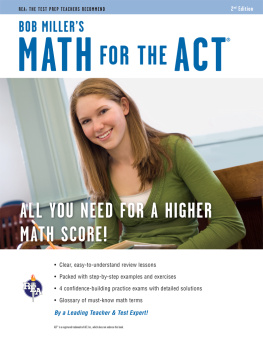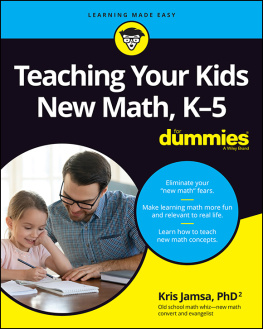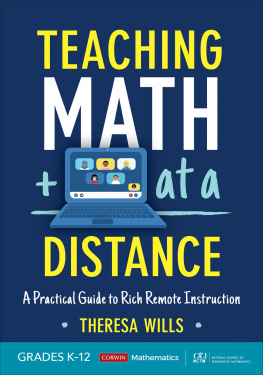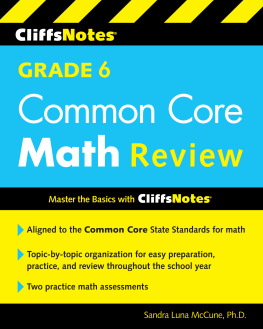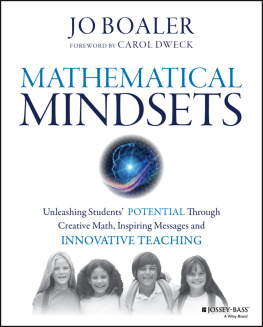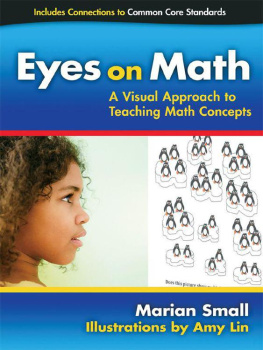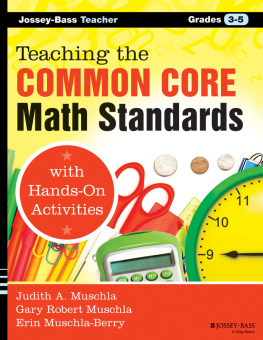ACKNOWLEDGMENTS
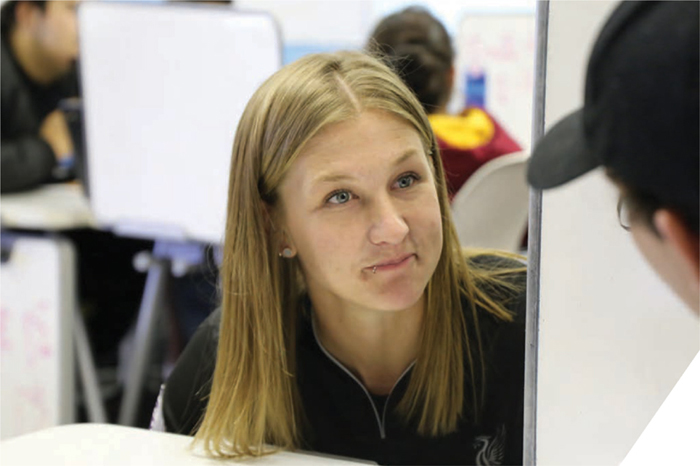
I never expected to write a book. Truth be told, I couldnt have written a book without a plethora of support at my side. I would like to extend thanks that I can never fully repay.
To Stenhouse Publishers, who allowed me this opportunity I never thought Id have. And specifically, to my editor, Tracy Zager, who helped the words in this book become the best version of themselves. This book is here because Tracy encouraged me to write it; its coherent because she edited it.
To my colleaguesyou took up my slack as I spent time writing every week. Im grateful to work at New Tech Network, which allowed and encouraged me to give this a shot.
To Megan Pacheco, who supported me when I was a teacher and who supports me now as a colleague and a friend. From the very beginning, she provided me with books about math instruction that we would discuss at length. I hope shell hand this book to someone to enhance their own learning.
To Kevin Gant, who helped me refine my ideas as a young teacher and continues to sharpen them to this day.
To Rick Lear, who took a chance on me and never ceased to ensure that I was happy and well-fed.
To Zac Wheatcroft, who made this book come alive with his beautiful photography that accurately captured the best of teaching and learning, and also supplied the diagrams that made it clear what I was trying to say. To the incredible and patient production and design teams at StenhouseStephanie Levy, Jay Kilburn, Gina Poirier, Grace Makleythank you for delivering such a beautiful physical book for such a persnickety author.
To my dad, who would prompt me to iteratively double numbers in my head until I couldnt go any higher or I fell asleep.
To my mom, who somehow raised three boys and made each of us feel safe and important.
To my wonderful wife, Stephanie, who helps me see the endless colored ways. She makes it possible for me to experience these great classrooms and keeps me sane as I try to figure out what it all means.
To Fawn Nguyen, who has the luckiest students in the world and whose writing clarifies my own thinking.
To the educators that I consistently observed and leaned on as my brain trust: Dina Mahmood, Kala Gabler, Kate Byers, Brett Eberly, Brette Woessner, Des Zuberi, Jeff de Varona, Lea Blair, Hilary Preston, and Missy Tydlacka.
To the students who opened up their academic and personal lives to me. They were honest and inspirational. In particular, one young woman from Southern California described how much shes grown over the past couple years. Throughout the writing of this book, I can only hope Ive grown too.
APPENDICES
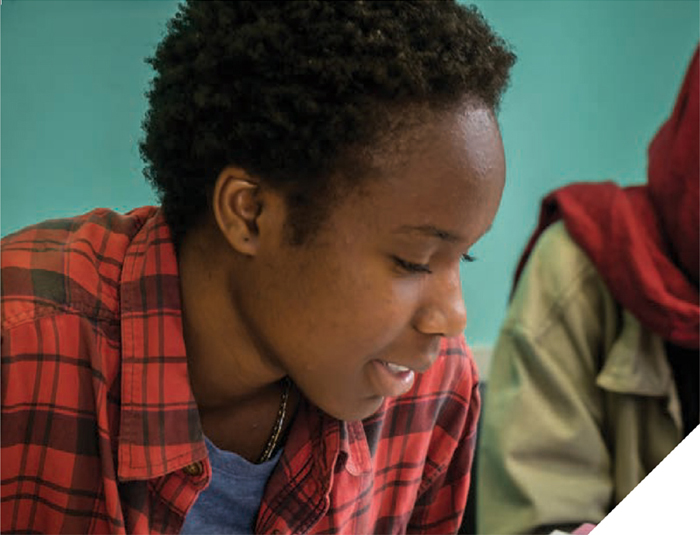
APPENDIX A
Suggested Math Reading/Viewing/Listening
Teachers and students have greater access to the work of mathematicians than ever before. Readily accessible books, videos, podcasts, and articles can allow authentic mathematical work into your school. Should you choose to steep yourself in the work of mathematicians, youll find that these artifacts are approachable and delightful. You may want to use them to rethink your classroom or simply to satisfy your own curiosity.
Consider this a starter list of potential artifacts to read, watch, or listen to.
Books
How Not to Be Wrong: The Power of Mathematical Thinking by Jordan Ellenberg
The Joy of x: A Guided Tour of Math, from One to Infinity by Steven Strogatz
Thinking Statistically by Uri Bram
Women in Mathematics by Lynn Osen
Measurement by Paul Lockhart
Articles
A Mathematicians Lament by Paul Lockhart, Mathematical Association of America
No Such Thing as a Math Person by Perri Klass, MD, New York Times
The Unforgiving Math That Stops Epidemics by Tara Smith, Scientific American
How Animals Got Their Spots and StripesAccording to Math by Thomas Woolley, Scientific American
The Pursuit of Beauty by Alec Wilkinson, New Yorker
Videos
Steven Strogatz and Hilberts Infinite Hotel
Navajo Math Circles, PBS
The Mathematics of Love, Hannah Fry
The Magic of Fibonacci Numbers, Arthur Benjamin
Why I Fell in Love with Monster Prime Numbers, Adam Spencer
The Beautiful Minds, Cedric Villani
Audio
Remembering Maryam Mirzakhani, NPR
Mathematics Unintended Consequences, In Our Time
How Much Brain Damage Do I Have? Freakonomics
Henri Poincar, A Brief History of Mathematics
On Average, 99% Invisible
APPENDIX B
Profiles of Notable Mathematicians
Throughout this book, weve gotten glimpses into the vast, varying world of mathematicians work and personalities. Authentic mathematical work and the dispositions of mathematicians have influenced educators as theyve rethought their approach to math. In this appendix are brief profiles of a few of my favorite mathematicians, from the eighth century to the present day.
When students think of mathematicians, they typically think of white men working in isolation on indecipherable problems. Be sure to provide models of mathematicians who represent the diversity of those in the field by race, gender, sexual orientation, personality, and ways of working.
Going forward, I hope youll create your own list of all-star mathematicians for your students. Annie Perkins has created a more comprehensive database of mathematicians at her website arbitrarilyclose.com.
Maryam Mirzakhani (19772017)
Maryam Mirzakhani was born in Tehran, Iran, where she attended Sharif University. While there, she won gold medals in the International Mathematical Olympiad after being the first woman on the Iranian team. After earning her degree, she moved to the United States to attend graduate school at Harvard. Later, she became a professor at Stanford University.
In 2013, Mirzakhani coauthored a paper in which she and peer Alix Eskin analyzed the path of a pool ball around a polygonal pool table. In 2014, she became the first woman to win the prestigious Fields Medal, the equivalent of a Nobel Prize in Mathematics, for her striking and highly original contributions to geometry and dynamical systems (Math Union 2014). Her work was as delightful as it was insightful. Her daughter once referred to Mirzakhanis mathematical work as painting.
Martha Euphemia Lofton Haynes (18901980)
Martha Euphemia Lofton Haynes was born and lived her entire life in Washington, DC, and was given numerous awards for her contribution to the betterment of her community. In 1943, she became the first African American woman to obtain a PhD in mathematics, achieving this distinction with the successful dissertation at Catholic University of America titled The Determination of Sets of Independent Conditions Characterizing Certain Special Cases of Symmetric Correspondences.
Dr. Haynes taught first grade through high school in the DC public school system for forty-seven years. After her public teaching career, she became a professor and established the mathematics department at Miner Teachers College.
Nancy Grace Roman (1925 )


